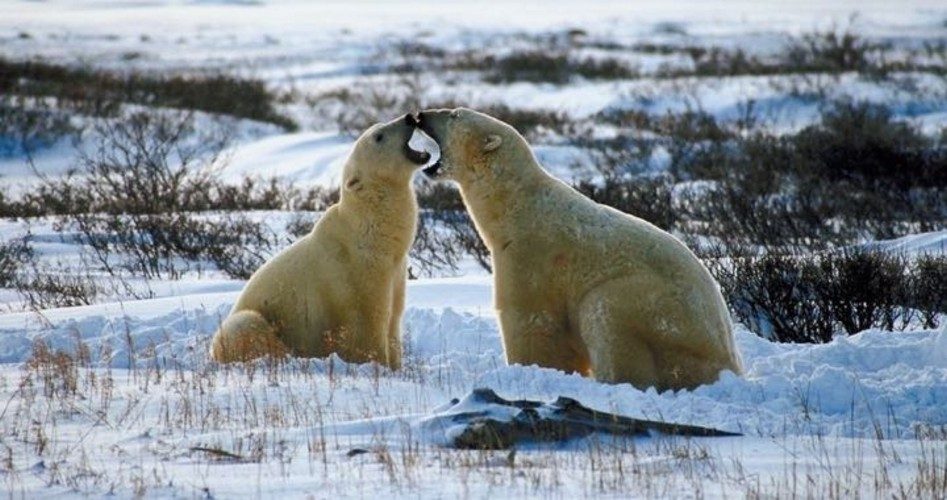
“There’s too many polar bears now.” This observation, which runs counter to the global-warming dogma that rising temperatures are decimating bear populations, was made by Eskimos — people who actually live among the bears.
In fairness, this story has not been reported accurately: Many sources have emphasized how Canadian Eskimos have said there are more “fat” bears, and this is true; however, other Indians claim the bears seem to be skinnier (no, there were no fun-house mirrors around). But they all agree on one thing: There are more bears now than in generations — at least in their area.
The Indians’ observations were presented in the recently published research paper “Inuit perspectives of polar bear research: lessons for community-based collaborations,” by Pamela B.Y. Wong, Department of Ecology and Evolutionary Biology, University of Toronto, et al. And these observations coincide with the findings of certain scientists who tell us that warnings of polar bear imperilment are mere climate alarmism.
{modulepos inner_text_ad}
Writing of how the Eskimos report more bear/human contact than ever before, the paper informs that some “participants attributed interactions with bears to cyclical changes in polar bear distribution.” It then quotes an Eskimo source:
Back then there used to hardly be any bears … 1920s, the father-in-law said they used to go miles and miles by dog team, or by walking to go hunt polar bears … but after 1980s, to now there’s a lot of bears … 1920s, his father-in-law was saying that there were a lot of bears back then … few years later they were all gone … and now they’re all back … I think it goes like that, back and forth. (AB12) Our elders, they say, they migrate, into other area … for years, and then they come back … that’s what we’re experiencing now … back in early 80s, and mid 90s, there were hardly any bears … there’s too many polar bears now.
All the Eskimo study participants believe that the bears are more aggressive now. One explained this by saying that the bears are “smart” and “know that they won’t be shot at … now, but back then [decades ago] they used to be afraid … knowing that they’ll be shot.”
Of course, climate alarmists may claim this is due to bears having to search inland for food. (It’s mildly surprising they didn’t blame the aggression on white privilege. Are brown and black bears doing as well?) Yet the Indians explain that bears are opportunistic and are attracted to human dumps, which didn’t exist many years ago.
No doubt. It’s as when I saw a bear feeding out of a convenience-store dumpster in upstate New York: Being “carnivores with a sweet tooth,” as someone close to me put it, bears love the goodies we discard (old donuts, cookies, etc.) — and it saves them the trouble of having to hunt or forage.
This “dumpster diving,” mind you, is why some Eskimo respondents are concerned about the bears’ health. One participant said that “before the 70s, it was much cleaner, you know, the tundra was much cleaner, the town was cleaner[,] but these days we have dumps.” (Time to call Michelle Obama and her diet police? Hey, then you’ll see some hungry bears.)
These observations may seem a tad too anecdotal to many, but they accord with scientific findings. Just consider Dr. Judith A. Crockford, an adjunct professor of zoology at the University of Victoria, British Columbia and a leading polar bear expert. In 2015, she wrote, “On almost every measure, things are looking good for polar bears…. Scientists are finding that polar bears are well distributed throughout their range and adapting well to changes in sea ice,” reported the Express.
In 2009, the liberal Guardian informed that marine mammal expert and World Wildlife Fund (WWF) spokesman Dr. Tom Arnbom believes that polar bear populations in Norway are increasing. In 2007, Professor Bjørn Lomborg, former director of the Danish government’s Environmental Assessment Institute, stated that the polar bear was not imperiled and that the only two polar bear populations in decline were in areas that were getting colder (no surprise; plummeting temperatures aren’t good for life in general). And just last Thursday, Climate Depot summed up the recent research on polar bears, writing that “92% of the subpopulations studied either remaining stable or growing in recent years.”
This is not surprising. With hunting now greatly limited and habitat loss not an issue (beach resorts and strip malls don’t pop up much in the Arctic), it only makes sense that polar bears would proliferate. As the much assailed climate realist Dr. Crockford put it, “This is the truth the world needs to hear: the experts were wrong. Polar bears have not been driven to the brink of extinction by climate change, they are thriving.” (Video below of Crockford talking about the polar-bear-extinction hysteria. Relevant portion begins at 2:37.)
Not only are polar bears not imperiled, but there may be no evidence they ever were. Note here that the WWF’s Dr. Arnbom has admitted as much, saying that the “difficulty is that monitoring populations is extremely difficult because they are very hard to find and very expensive to follow[,] so it is difficult to get hard data.” For this reason, the Eskimos’ observations and their elders’ oral history may be as good a guide as any. Of course, though, maybe now they’ll be accused of being agenda-driven “deniers,” too.
Photo: Clipart.com



